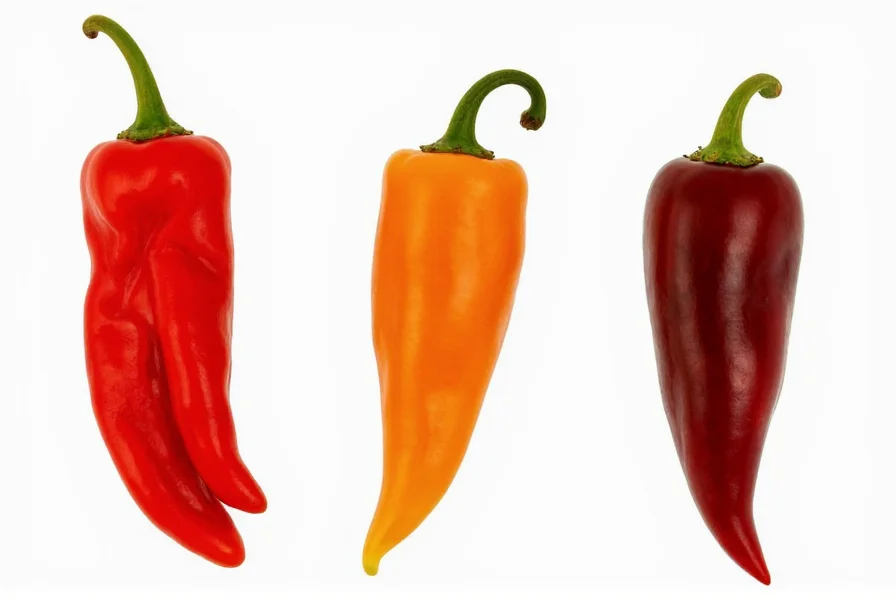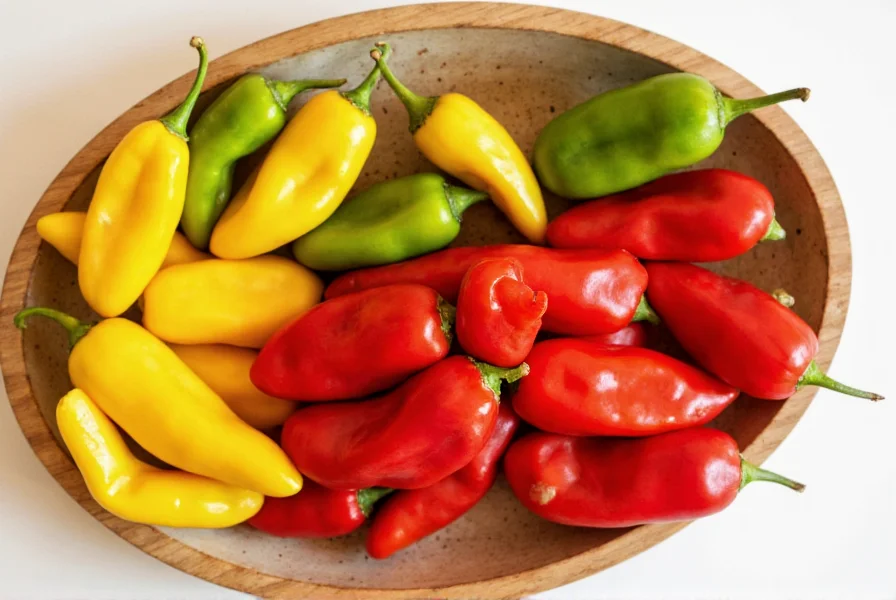Pepper varieties span an extraordinary spectrum of flavors, colors, and heat levels that have evolved over centuries of cultivation. Understanding these differences helps gardeners select appropriate plants and enables cooks to create balanced dishes with precision. From the zero-Scoville bell peppers to the 2.2 million SHU Carolina Reaper, each variety serves distinct purposes in both agriculture and cuisine.
Understanding Pepper Classification Systems
Peppers are primarily classified by two systems: botanical classification and heat measurement. The five domesticated Capsicum species include annuum, chinense, frutescens, baccatum, and pubescens. Most common varieties belong to Capsicum annuum (including bell peppers and jalapeños) or Capsicum chinense (habaneros and ghost peppers).
The Scoville Scale remains the standard for measuring pungency, though modern high-performance liquid chromatography (HPLC) provides more precise capsaicin measurements. Understanding these classification systems helps identify different types of bell peppers versus genuinely hot varieties when selecting seeds or shopping for ingredients.

Mild Pepper Varieties (0-5,000 SHU)
Sweet peppers contain no capsaicin, registering 0 on the Scoville scale. These sweet pepper varieties for gardening are ideal for fresh eating, salads, and stuffed dishes:
- Bell peppers - Available in multiple colors (green, red, yellow, orange, purple), with green being least sweet and purple offering unique anthocyanins
- Pimento - Heart-shaped, sweet peppers commonly used in cheese spreads and stuffed olives
- Banana peppers - Mildly tangy, often used in sandwiches and salads
- Pepperoncini - Slightly tangy, commonly pickled for Greek and Italian dishes
Medium-Heat Pepper Varieties (5,000-50,000 SHU)
These versatile culinary pepper varieties provide noticeable heat without overwhelming dishes:
- Jalapeño - The most popular medium-heat pepper (2,500-8,000 SHU), essential for salsas and nachos
- Serrano - Brighter, grassier flavor than jalapeños (10,000-23,000 SHU), ideal for fresh salsas
- Fresno - Similar heat to jalapeños but fruitier flavor, excellent for roasting
- Chipotle - Smoked and dried jalapeños offering complex smoky flavor
- Guajillo - Dried mirasol peppers with berry-like notes, common in Mexican mole sauces
Hot Pepper Varieties (50,000-300,000 SHU)
These hot pepper varieties for cooking require careful handling but deliver distinctive flavors:
- Habanero - Tropical fruit notes with intense heat (100,000-350,000 SHU), foundational in Caribbean cuisine
- Scotch Bonnet - Similar to habanero but with distinctive bonnet shape, essential in jerk seasoning
- Cayenne - Long, slender peppers (30,000-50,000 SHU) commonly dried and ground into powder
- Thai Bird's Eye - Small but potent (50,000-100,000 SHU), crucial in Southeast Asian cooking
- Tabasco - The pepper used in Tabasco sauce (30,000-50,000 SHU), with vinegar-like tang
| Pepper Variety | Scoville Range | Flavor Profile | Common Uses |
|---|---|---|---|
| Bell Pepper | 0 SHU | Sweet, vegetal | Salads, stuffed peppers, stir-fries |
| Jalapeño | 2,500-8,000 SHU | Grassy, bright | Salsas, nachos, pickled peppers |
| Habanero | 100,000-350,000 SHU | Tropical fruit, floral | Hot sauces, Caribbean dishes |
| Ghost Pepper | 855,000-1,041,427 SHU | Smoky, sweet initially | Extreme hot sauces, challenges |
| Carolina Reaper | 1,400,000-2,200,000 SHU | Fruity, then intense heat | Competitive eating, specialty sauces |
Superhot Pepper Varieties (300,000+ SHU)
These extreme heat pepper varieties require serious caution and proper handling techniques:
- Ghost Pepper (Bhut Jolokia) - First officially recognized chili over 1 million SHU, with delayed heat onset
- Trinidad Moruga Scorpion - Incredibly potent (1.2-2 million SHU) with complex fruit flavors
- Carolina Reaper - Current Guinness World Record holder (1.4-2.2 million SHU), developed through selective breeding
- 7 Pot Douglah - Chocolate-colored variety with intense, lingering heat
- Dorset Naga - British-bred superhot with distinctive heat pattern

Growing Different Pepper Varieties
Successful cultivation of pepper varieties for container gardening requires understanding their specific needs:
Most peppers thrive in warm conditions with 6-8 hours of direct sunlight. Capsicum chinense varieties (habaneros, ghost peppers) typically require longer growing seasons (90-120 days) compared to Capsicum annuum varieties (70-90 days). Container gardeners should select compact varieties like 'Thai Hot' or 'Apache' peppers, which perform well in pots with proper drainage.
When growing ornamental pepper plant varieties, consider both aesthetics and edibility. Many ornamental peppers produce small, colorful fruits that are technically edible but often extremely hot. Popular ornamental varieties include 'Black Pearl' with dark foliage and 'Medusa' with twisted fruit shapes.
Culinary Applications of Pepper Varieties
Understanding the flavor profiles beyond heat is crucial for effective use of different chili pepper varieties in cooking:
Sweet peppers work best in dishes where their natural sugars can caramelize, such as roasted vegetable medleys. Medium-heat peppers like jalapeños shine in fresh preparations where their grassy notes complement other ingredients. Hotter varieties often benefit from cooking, which mellow their heat while preserving distinctive flavor compounds.
When substituting one pepper for another, consider both heat level and flavor profile. A habanero won't work as a direct substitute for a jalapeño due to its significantly higher heat and different flavor characteristics. For most recipes, maintaining the intended flavor profile matters as much as matching heat levels.
Selecting and Storing Pepper Varieties
Choose peppers that feel heavy for their size with taut, shiny skin. Avoid specimens with wrinkles, soft spots, or discoloration. For pepper heat scale comparison reference, remember that heat concentrates in the placenta (white ribs) and seeds, not the flesh.
Store peppers in the crisper drawer of your refrigerator for up to two weeks. For longer preservation, freeze whole peppers or slice and freeze for cooking. Drying remains the traditional method for preserving hot peppers, concentrating both flavor and heat while enabling storage for months.
Frequently Asked Questions
What are the most common bell pepper color varieties?
Bell peppers come in multiple colors representing different maturity stages: green (least mature), yellow, orange, red (fully mature), and specialty varieties like purple and chocolate. Red bell peppers have been ripening longest, developing higher sugar content and vitamin levels compared to green peppers.
Which pepper varieties are best for beginner gardeners?
Beginner gardeners should try 'California Wonder' bell peppers, 'Jalapeño M' varieties, or 'Hungarian Wax' peppers. These easy-to-grow pepper varieties are relatively disease-resistant, produce reliably, and adapt well to various growing conditions. They typically mature within 70-80 days from transplanting.
How do I safely handle extremely hot pepper varieties?
When handling superhot peppers like ghost peppers or Carolina Reapers, always wear nitrile gloves and avoid touching your face. Work in a well-ventilated area as capsaicin vapors can irritate eyes and lungs. Never use latex gloves as capsaicin can penetrate them. After handling, wash hands thoroughly with soap and water, and clean all surfaces with vinegar solution to neutralize residual capsaicin.
What determines the heat level in different pepper varieties?
Pepper heat comes from capsaicinoids, primarily capsaicin, concentrated in the placenta (white ribs) and seeds. Heat levels are genetically determined but influenced by growing conditions - stressors like temperature fluctuations, water scarcity, and nutrient limitations can increase capsaicin production. The Scoville scale measures these capsaicin concentrations, with higher numbers indicating greater heat intensity.
Can I grow multiple pepper varieties in the same garden?
Yes, but maintain proper spacing (18-24 inches between plants) and consider potential cross-pollination if saving seeds. Different pepper varieties for home gardening can coexist, but avoid planting sweet and hot varieties too close together if you plan to save seeds, as cross-pollination may produce unexpectedly hot offspring. Most gardeners successfully grow multiple varieties with proper planning and spacing.











 浙公网安备
33010002000092号
浙公网安备
33010002000092号 浙B2-20120091-4
浙B2-20120091-4